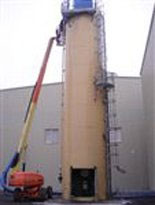
The engineering firm designed and engineered all aspects of the brick plant’s automated production process, from the raw material delivery, storage, and grinding systems to the computerized supervisory control system that monitors and manages brick production. Part of the production process involves transferring fuel-grade petroleum coke from a 70-ton-capacity silo through a screw feeder to a pneumatic conveying system that feeds it into a kiln. It is then combusted to provide heat for curing of the bricks.
Since the petroleum coke becomes compacted in the silo’s bottom cone section, the engineering firm originally installed pneumatically actuated vibration pads to prevent bridging and arching and to aid material discharge from the silo. However, during the feed system testing, the material discharged from the silo to the screw feeder in large chunks rather than as a continuous material stream at a controlled feedrate. This led to an unreliable and inconsistent feedrate to the pneumatic conveying system, which in turn adversely affected the kiln’s performance and efficiency. Additionally, the screw feeder wasn’t properly calibrated for feeding petroleum coke into the pneumatic conveying system. A 1-inch gap between the feed screw’s outer diameter and the feed tube’s inner wall allowed material to continue discharging even when the feeder was stopped.
The engineering firm needed to find a better way to feed the petroleum coke into the pneumatic conveying system to ensure optimal kiln performance.
Finding a feeding solution
The engineering firm’s headquarters in Paris has worked with many European equipment suppliers for various projects throughout the continent. For one such project, it successfully worked with a Paris-based supplier that provided a precision screw feeder for accurately feeding a dry powder from a silo to a downstream process. Since this supplier also has an office in Chicago for servicing the North American market, the engineering firm decided to call the supplier about the problem. The supplier, Sodimate Inc., supplies systems for discharging, conveying, weighing, and feeding dry bulk solids for the water and waste water and power generation industries as well as metallurgy, mining, pharmaceutical, and other industries.

“At first, they only wanted one of our precision screw feeders, thinking that it would solve their feeding problem,” says Patrick Esor, Sodimate general manager. “However, I told them that even if they installed a new volumetric screw feeder they wouldn’t have control of the material discharged from the silo because the vibration pads are not correlated to the feeder speed and would still cause inconsistence unloading into the system. So I told them that along with the screw feeder I would provide a complete mechanical discharger and feed system that would control the discharge of the material and solve their feeding problems.”
In December 2008, the discharge and feeding system arrived at the brick plant where it was quickly and easily installed below the silo’s cone section. The system consists of an Arch Breaker DDS 400 mechanical silo discharger, a correlated screw feeder,and a PLC controller. The arch breaker provides mechanical agitation inside the silo cone, without air injection (fluidization) or vibration (bin activator or pads), and eliminates arching and bridging, to ensure continuous material discharge to the screw feeder. It can be used with large silos big bag unloaders and small storage hoppers..
The silo unloader has a 16-inch-diameter cylindrical body hopper and is used to control the density of the product discharged from the silo. An 8-inch-diameter inlet connected to the silo cone flange with a rectangular bottom opening to the volumetric screw feeder. A single-speed motor mounted outside the arch breaker’s body drives the mechanical silo unloader. The three-feet-long vertical shaft can be set to rotate from7 to 50 rpm, depending on the discharge rate. Several flexible blades mounted at intervals on the shaft extend out horizontally into the silo cone to just near the inside wall slope.
The 7-foot-long screw feeder is a 4-inch-diameter Shaftless screw (flexible) and is installed at a 15-degree angle directly below the mechanical arch breaker discharger. The screw feeder’s variable-speed motor allows it to feed material to the pneumatic conveying system at up to 20 t/h, adapting to the kiln’s desired temperature. The PLC controls the arch breaker and screw feeder operation and is programmed with recipe settings for each type of brick made by the brick plant.
During operation, the silo unloader operates at a fixed speed and the screw conveyor operates at a variable speed determined by the recipe called up on the PLC. As the mechanical arch breaker rotates inside the silo cone, its flexible blades condition the material to not bridge, arch or segregate as if it was used with vibration systems, and allows it to easily discharge from the silo into the arch breaker hopper. Sincethe arch breaker’s body is larger than the silo cone discharge opening, the material’s bulk density remains constant before entering the screw feeder, which helps maintain volumetric feeding accuracy.
To ensure that all the material in the silo unloader body hopper moves into the screw feeder, two rigid sweeper arms are mounted onto the vertical shaft about 0.5 inch above the arch breaker’s bottom. The arms extend out horizontally in opposite directions, and as the arch breaker operates, they rotate with the vertical shaft and continuously move the material into the screw feeder inlet. Since the screw flights are always 100 percent filled with material, the screw feeder is able to consistently feed the material volumetrically to the pneumatic conveying system with ±2 percent accuracy, providing a controllable material stream to the kiln.
“Because the material is so fine and abrasive, we modified the arch breaker to have a direct-drive shaft by installing the motor vertically under the screw feeder and using a stainless steel sleeve adapter,” says Esor. “Typically, the motor is installed horizontally next to the arch breaker with its counter-shaft gearbox inside the arch breaker. But we didn’t want to expose any of the gearbox seals to the material because it was occurring with the previous equipment and we knew that the material would wear through the seals and leak into the gearbox, which would have caused maintenance issues.”
Successfully controlling material feedrates
Since installing the new mechanical discharger and feeding system, the engineering firm has found that the petroleum coke feedrate to the pneumatic conveying system to be much more controllable and consistent. “Improving the feedrate from the silo has given us better control of feeding the petroleum coke into an airflow, which improves the kiln performance because we can better regulate its temperature,” says Patrice Dauba, Keyria project manager. “In addition to better feed control, the tight tolerance between the feed screw’s flights and feed tube prevents material from discharging from the feeder when it’s stopped.
The system was also pretty easy to install, and it only takes about fifteen minutes to change a screw. You just unscrew four bolts, take out the motor, remove and replace the screw, put it back together, and you’re done.”











